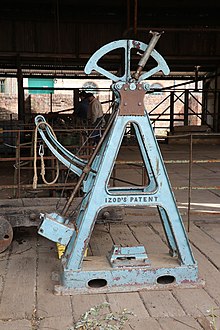Pendulum hammer
A pendulum hammer is used for the impact test . It is a wedge-shaped mass that is suspended from a free-swinging pendulum .
The test body - usually made of plastic or metal - breaks when the pendulum hammer hits. Depending on the behavior of the material , the pendulum is more or less braked or deflected. The materials tester recognizes that due to the deflection of energy has absorbed the examinee and can thus the toughness of the material can be calculated. The pendulum is built into a pendulum hammer. With today's pendulum impact testers, the deflection is measured and evaluated electronically.
species
The pendulum hammer is designed differently depending on the standard . It differs in shape, mass and pendulum length.
Charpy hammer
The picture shows a Charpy pendulum according to DIN EN ISO 179 (standard for plastics for determining the Charpy impact strength ). In DIN EN ISO 179-1, pendulums with 50 J ( Joule ), 25 J, 15 J, 7.5 J, 5 J, 4 J, 2 J, 1 J and 0.5 J are to be used. In the case of a Charpypendel, the sample rests on both supports and is knocked through in the middle.
The method is usually not suitable for rigid foams and laminates with a foam core.
The ASTM D 6110 standard specifies the 2.7 J, 5.4 J, 10.8 J, 21.6 J pendulums. With this standard, the pendulum hammer reaches a speed of 3.46 m / s on impact, which results from the standardized drop height of 610 mm.
Izod hammer

In the case of the Izod pendulum according to DIN EN ISO 180 (standard for plastics for determining the Izod impact strength ), the test specimen is clamped on edge and struck across the board. According to DIN EN ISO 180, Izod pendulums are available in the following variants (impact energies): 22 J, 11 J, 5.5 J, 2.75 J and 1 J.
Impact pull
A third variant of the pendulum hammer is the hammer pull hammer according to ISO 8256 . In this test, the specimen is stretched, similar to a tensile test . Pendulums with 2 J and 4 J are used for this. Here speeds between 2.6 and 3.2 m / s must be maintained. For the 7.5 J, 15 J, 25 J and 50 J pendulums, speeds of 3.4 to 4.1 m / s must be observed.
Hemisphere
A pendulum hammer is also used in determining rebound resilience for rubber and rubber . The hammer is also referred to as a hammer fin ( hemisphere ) and has an impact energy of 0.5 J.
literature
- Erich Siebel (Hrsg.): Handbook of materials testing. First volume, Springer Verlag Berlin Heidelberg GmbH, Berlin Heidelberg 1940.
- Otto Wawrziniok: Handbook of materials testing for mechanical and civil engineers. Springer Verlag Berlin Heidelberg GmbH, Berlin Heidelberg 1908.
- Klaus Urban: Materials Science and Technology. Springer Verlag Berlin Heidelberg, Berlin Heidelberg 2015, ISBN 978-3-662-46236-2 .